Rimbi Falls in Sikkim is a serene waterfall set amidst dense forests. Its gentle flow over rocks creates a peaceful and beautiful scene, drawing visitors seeking peace and natural beauty. The clear waters gather in a calm pool below, offering a refreshing spot to relax and enjoy the quiet surroundings. Locals hold Rimbi Falls in high regard not just for its beauty but also for its cultural significance, making it a cherished place in Sikkim’s natural landscape.
Picture yourself walking through a lush forest in Sikkim, where the air is filled with the scent of wildflowers and the sound of birds singing. As you approach Rimbi Falls, the sound of water rushing over rocks grows louder, leading you to discover a stunning sight: clear water flowing gracefully down the rocks.
Location of Rimbi Falls
Rimbi Falls is located near Pelling in West Sikkim, India. Pelling is a popular tourist destination known for its stunning views of the Kanchenjunga mountain range and its proximity to various natural attractions, including waterfalls like Rimbi Falls. The falls are easily accessible by road from Pelling, making it a convenient spot for visitors to explore and enjoy the natural beauty of Sikkim.
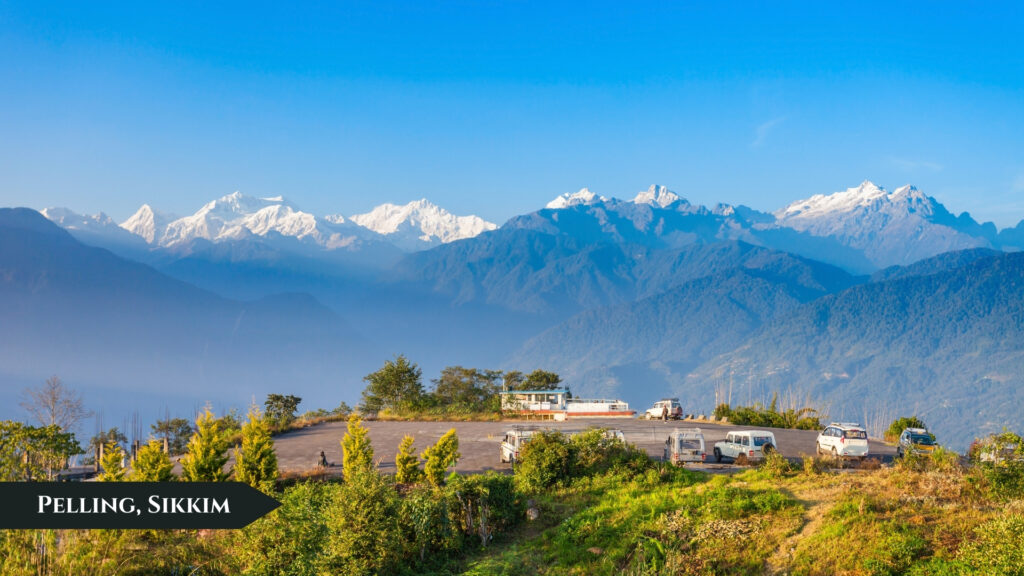
Features Of Rimbi Falls
Rimbi Falls in Sikkim is a truly special place, where nature’s beauty unfolds in a serene and peaceful setting. As you approach the falls, the sound of water rushing over rocks fills the air, immediately calming your senses. The waterfall itself is a sight to behold, with water cascading down in gentle steps, creating a soothing melody that resonates throughout the surrounding forest.
One of the most enchanting features of Rimbi Falls is the crystal-clear pool that forms at its base. Here, you can dip your feet into the cool water or simply sit and enjoy the refreshing spray from the falls. It’s a perfect spot to unwind, surrounded by the vibrant greenery and the sweet fragrance of wildflowers that fill the air.
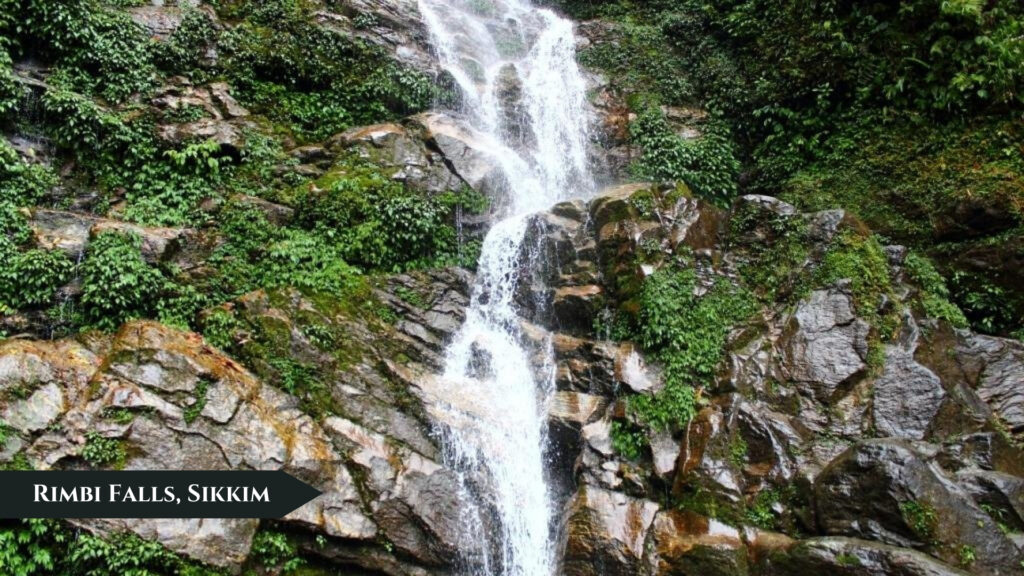
For the local community, Rimbi Falls holds deep cultural significance, often seen as a sacred place where traditions and spirituality converge with nature’s bounty. Families and friends gather here not just to relax but also to connect with their heritage and find solace in the peaceful atmosphere.
How to Reach Rimbi Falls
By Air
The nearest airport to Rimbi Falls is Bagdogra Airport in West Bengal. From there, you can take a flight to reach Bagdogra and then travel by road to Sikkim. The distance from Bagdogra Airport to Rimbi Falls is approximately 140 kilometers, and the journey takes around 4-5 hours by road.
By Train
The nearest major railway station to Rimbi Falls is New Jalpaiguri (NJP) Railway Station, also located in West Bengal. From NJP, you can hire a taxi or take a shared jeep to reach Pelling in Sikkim. The journey from NJP to Pelling is approximately 130 kilometers and takes about 4-5 hours.
By Road
Rimbi Falls is well-connected by road, and the most common way to reach is via Pelling. Pelling serves as a base for exploring nearby attractions including Rimbi Falls. You can hire a taxi or take a shared jeep from NJP or directly from Bagdogra Airport to Pelling, and then continue towards Rimbi Falls, which is about 10 kilometers away.
Tips for the Road Journey
- Travel Light: Roads in the region can be narrow and winding, so pack light and only bring essentials.
- Comfortable Clothing: Wear comfortable clothing and sturdy shoes suitable for walking around natural terrains.
- Snacks and Water: Carry snacks and enough water, especially if you plan to spend time exploring around the falls.
- Weather Awareness: Sikkim’s weather can change quickly, so check the forecast and carry appropriate clothing for sudden changes.
- Local Guidance: If you’re unfamiliar with the area, consider hiring a local guide who can navigate the roads and provide insights into the region’s culture and history.
Following these tips ensures a comfortable and enjoyable journey to Rimbi Falls, allowing you to fully immerse yourself in the natural beauty and cultural richness of Sikkim.
Best Time to Visit Rimbi Falls
The best time to visit Rimbi Falls in Sikkim is during the spring and autumn months, specifically from March to May and September to November. During these periods, the weather is generally pleasant with mild temperatures, making it ideal for exploring the outdoors and enjoying the natural beauty of the falls and its surroundings.
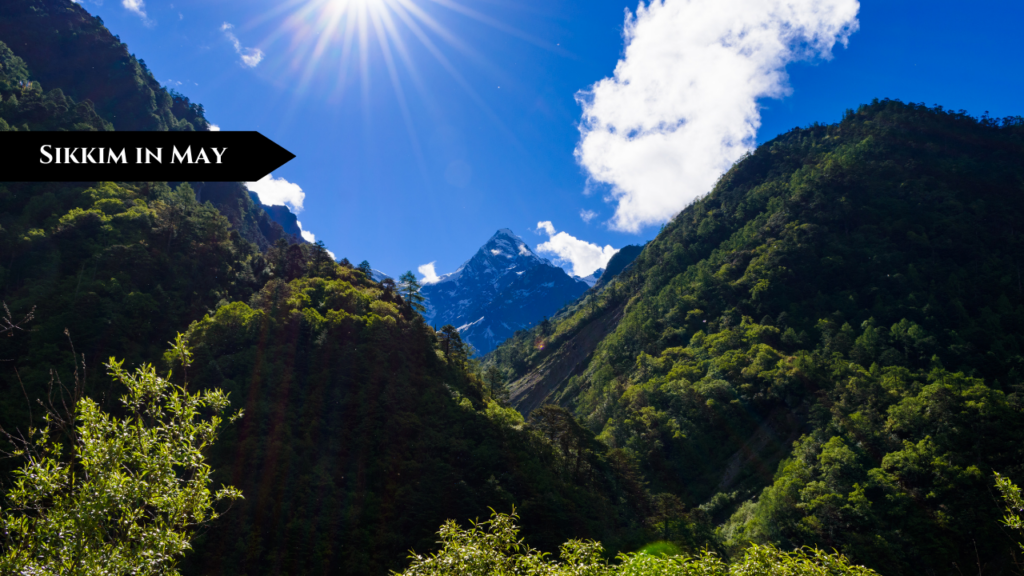
In spring (March to May), the weather is cool and comfortable, and the surrounding forests are lush and green with blooming wildflowers. This time is perfect for witnessing the falls at their fullest flow, fed by melting snow from the mountains.
Similarly, autumn (September to November) offers clear skies and pleasant temperatures, making it another great time to visit Rimbi Falls. The foliage begins to change colors, adding a vibrant backdrop to the cascading waters of the falls.
It’s advisable to avoid the monsoon season (June to August) due to heavy rainfall, which can make the roads slippery and the trails muddy. Winter (December to February) can also be quite cold, with temperatures dropping significantly, especially in higher altitudes like Sikkim.
By planning your visit during the spring or autumn months, you can maximize your enjoyment of Rimbi Falls and the surrounding natural beauty without the inconvenience of extreme weather conditions.
Timings and Entry Fee
Rimbi Falls in Sikkim generally does not have specific timings or entry fees, as it is a natural attraction accessible to visitors throughout the day. You can visit the falls at your convenience and enjoy its beauty at any time during daylight hours.
Since Rimbi Falls is located in a natural setting and is not managed as a commercial tourist spot, there is typically no formal entry fee. However, it’s always a good idea to check with local authorities or tourism offices for any updated information on regulations or changes in access policies.
For the most part, visitors can freely explore Rimbi Falls and its surroundings, soaking in the tranquil atmosphere and enjoying the natural splendor without restrictions on timings or additional costs.
Facilities Near Rimbi Falls
Near Rimbi Falls in Sikkim, you’ll find basic amenities such as parking facilities and public restrooms to cater to visitors. These amenities are typically provided to ensure comfort during your visit to the falls.
In terms of food and refreshments, there are small local eateries and stalls nearby where you can purchase snacks, drinks, and simple meals. These places offer a taste of local cuisine and provide refreshments to keep you energized during your exploration of Rimbi Falls and its scenic surroundings.
While the facilities near Rimbi Falls may be basic, they cater to the needs of tourists looking to enjoy the natural beauty of the area comfortably. It’s advisable to carry some water and snacks with you, especially if you have specific dietary preferences or require more substantial meals during your visit.
Tips for Visiting Rimbi Falls
- Timing: Visit Rimbi Falls during the spring (March to May) or autumn (September to November) for the best weather and clear views. These seasons offer pleasant temperatures and lush greenery, enhancing the beauty of the falls.
- Travel Arrangements: Plan your journey to Rimbi Falls well in advance. Arrange for transportation from nearby towns like Pelling, ensuring you have a comfortable and reliable mode of travel to reach the falls.
- Clothing and Footwear: Wear comfortable clothing and sturdy footwear suitable for walking on natural terrain. The area around Rimbi Falls can be uneven, so proper shoes will help you explore safely.
- Pack Essentials: Bring essentials such as sunscreen, sunglasses, a hat, insect repellent, and a reusable water bottle. These items will help you stay protected from the sun and hydrated during your visit.
- Respect Nature: Practice responsible tourism by respecting the natural surroundings. Avoid littering and follow designated trails to minimize your impact on the environment.
- Photography: Capture the beauty of Rimbi Falls with your camera or smartphone, but remember to be mindful of others and avoid obstructing pathways or viewpoints.
- Local Guidance: Consider hiring a local guide who can provide insights into the history, culture, and significance of Rimbi Falls. They can also help navigate the area and ensure you don’t miss any hidden gems.
- Safety: Be cautious near the water and follow any safety signs or guidelines. Rocks around waterfalls can be slippery, so watch your step and stay within safe viewing areas.
- Facilities: While basic amenities like parking and restrooms are available nearby, bring snacks or packed meals if you prefer specific dietary options or need extra sustenance during your visit.
- Enjoy the Experience: Finally, take your time to soak in the natural beauty and tranquility of Rimbi Falls. Enjoy the sound of cascading water, breathe in the fresh air, and appreciate the peaceful surroundings as you create lasting memories of your visit.
Places to Visit Near Rimbi Falls
Near Rimbi Falls in Sikkim, there are several other attractions and places worth exploring:
Khecheopalri Lake
Also known as the “Wishing Lake,” Khecheopalri Lake is a sacred lake revered by Buddhists and Hindus alike. It’s located about 9 kilometers from Rimbi Falls and offers a serene and tranquil environment surrounded by dense forests.
Pemayangtse Monastery
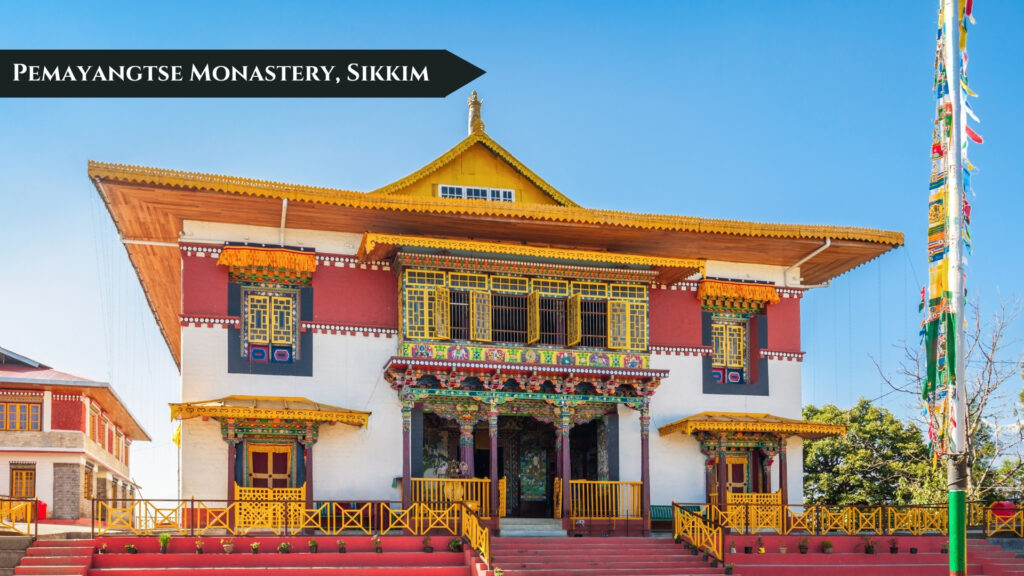
Situated in Pelling, approximately 10 kilometers from Rimbi Falls, Pemayangtse Monastery is one of the oldest and most important monasteries in Sikkim. It offers stunning views of the Himalayan ranges and houses ancient Buddhist artifacts and religious treasures.
Singshore Bridge
About 20 kilometers from Rimbi Falls, Singshore Bridge is one of the highest suspension bridges in Asia. It spans over a deep valley and offers panoramic views of the surrounding hills and forests.
Rabdentse Ruins
Located near Pelling, Rabdentse was the second capital of the former Kingdom of Sikkim. The ruins are nestled amidst thick forests and offer a glimpse into the region’s royal history and architectural heritage.
Yuksom
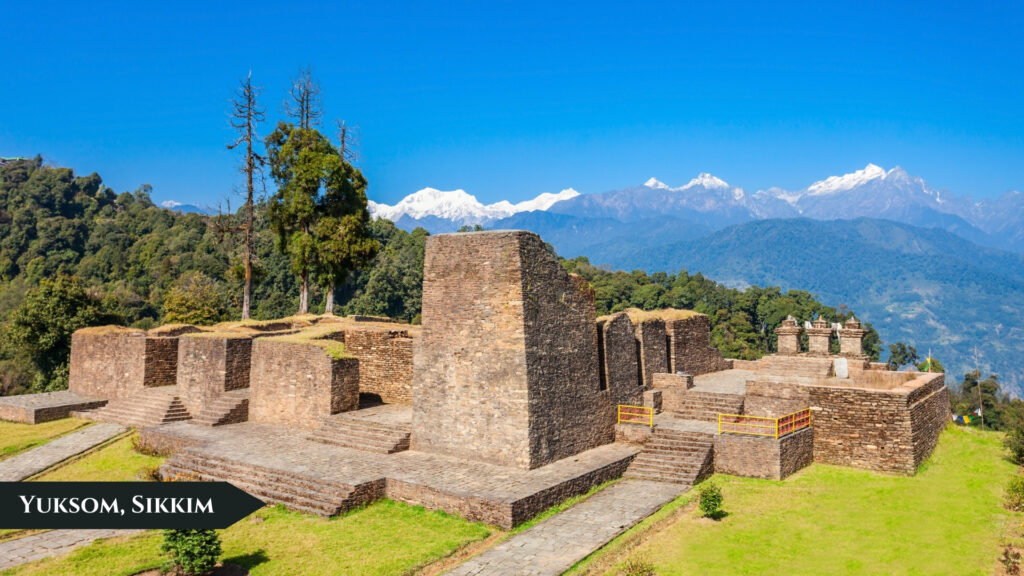
Yuksom, the first capital of Sikkim, is about 25 kilometers from Rimbi Falls. It’s a historical town and the starting point for the trek to Dzongri and Goechala. The town is known for its ancient monasteries, scenic beauty, and cultural richness.
Tashiding Monastery
Situated approximately 30 kilometers from Rimbi Falls, Tashiding Monastery is another significant religious site in Sikkim. It offers breathtaking views of Mount Kanchenjunga and hosts the Bumchu festival, a major religious event celebrated by Buddhists.
These attractions near Rimbi Falls offer a diverse range of experiences, from religious and historical sites to natural wonders and panoramic views of the Himalayas. Exploring these places will enrich your visit to Sikkim and provide a deeper understanding of its cultural and natural heritage.
Concluding Your Trip To Rimbi Falls in Sikkim
As your time at Rimbi Falls in Sikkim draws to a close, let the peaceful melodies of falling water and the verdant embrace of the forest linger in your memory. This place, where the gentle rush of the falls blends with the whispers of nature, has offered you a retreat from the hustle of everyday life.
Whether you came to marvel at the falls’ beauty, to find solace in its quietude, or simply to connect with the natural world, Rimbi Falls has left an imprint on your heart. As you reluctantly say goodbye, carry with you the tranquility you’ve discovered here – a reminder of the beautiful moments spent amidst Sikkim’s untouched landscapes. View my Instagram Profile to see the real-time updates on the experiences that I gather. Happy travels!
This blog is an epitome of my visit to this beautiful fall out of the many amazing waterfalls in Sikkim. If you are looking forward to traveling to Sikkim, you cannot miss going to this waterfall. Sikkim is a Himalayan paradise when it comes to coming close to nature and it is sort of incomplete without these waterfalls. Make sure to enjoy your trip.
Other Waterfalls In Sikkim
Here’s a list of some of the most famous waterfalls in Sikkim. If you’re looking for a detailed overview of the waterfalls in Sikkim, you can refer to my blog.
Kanchenjunga Falls

Kanchenjunga Falls streams gracefully in rich greenery, offering a beautiful sight to behold in the stunning landscapes of Sikkim. Named after the majestic Mount Kanchenjunga, this majestic waterfall holds visitors with its thunderous roar and scenic beauty, making it a must-visit destination for nature lovers and photographers alike.
Seven Sisters Fall
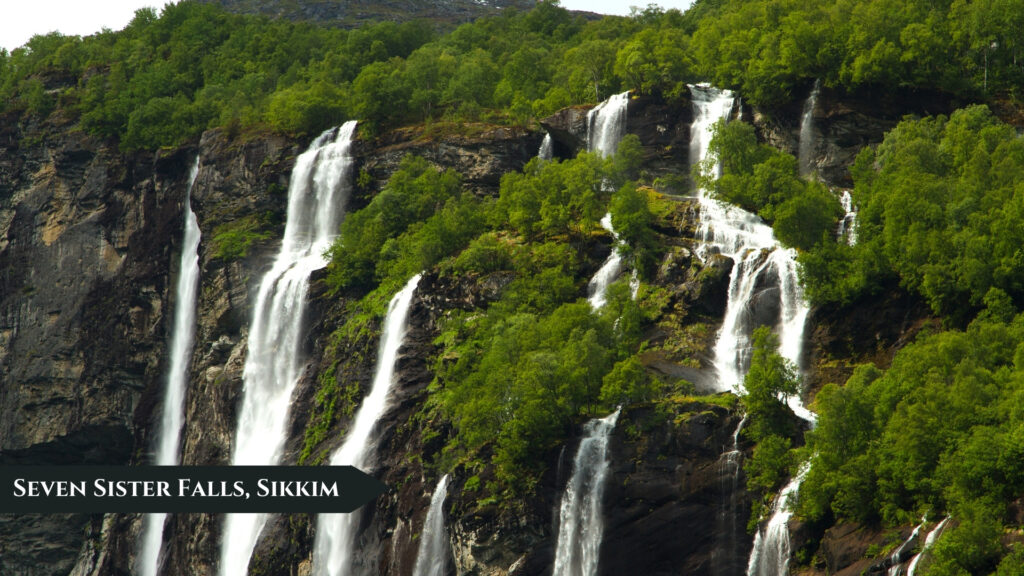
Seven Sisters Falls, named after the mythical Seven Sisters of Northeast India, is an amazing stream of waterfalls situated in dense forests and rolling hills. With its seven distinct streams plunging down rocky cliffs, this natural wonder creates a spectacle of unparalleled beauty, beautiful visitors with its sheer power and unreal charm.
Phamrong Falls
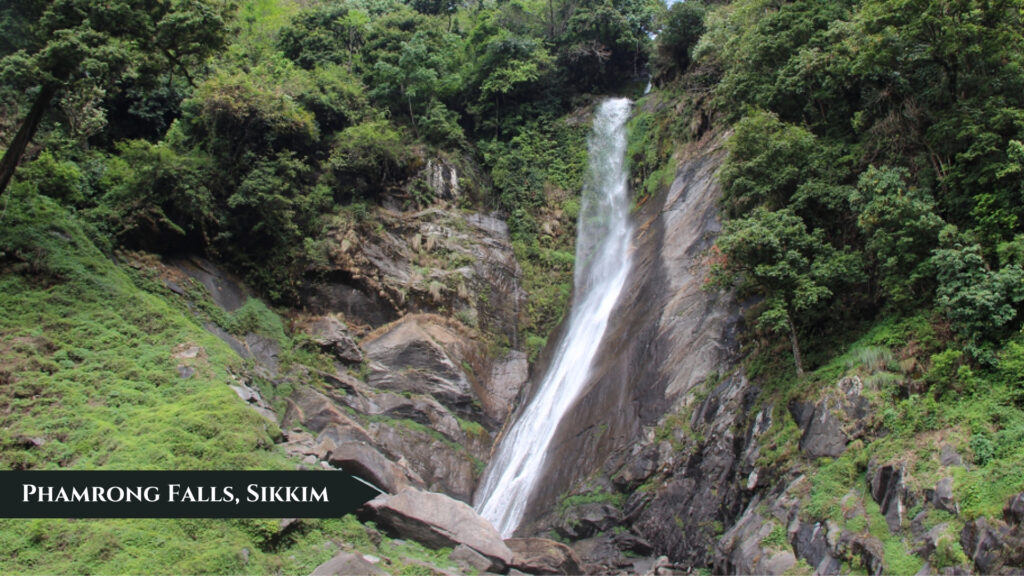
Phamrong Falls, situated in the beautiful hills of South Sikkim, is a majestic waterfall surrounded by rich greenery and stunning landscapes. Fed by the Rangpo River, these insta-worthy streams flow down rocky cliffs, creating a soothing melody of flowing water that resonates throughout the peaceful valley, making it a peaceful spot for picnics and relaxation.
Naga Falls

Naga Falls, located near the beautiful town of Dzongu in North Sikkim, is a beautiful waterfall surrounded by dense forests and mystical ambiance. Named after the legendary Naga tribes of the region, these majestic streams flow down rocky cliffs, creating a remembering sight that beckons travelers to drown themselves in the wonders of nature and explore the hidden treasures of the Himalayas.
Bhim Nala Falls

Bhim Nala Falls, situated in the beautiful hills of Sikkim, is a peaceful waterfall renowned for its natural beauty and peaceful ambiance. Fed by the Bhim Nala River, this insta-worthy stream streams down rocky cliffs, creating a beautiful spectacle of water and light that amazes visitors with its unreal charm, making it a favored destination for nature lovers and photographers alike.
Banjhakri Falls
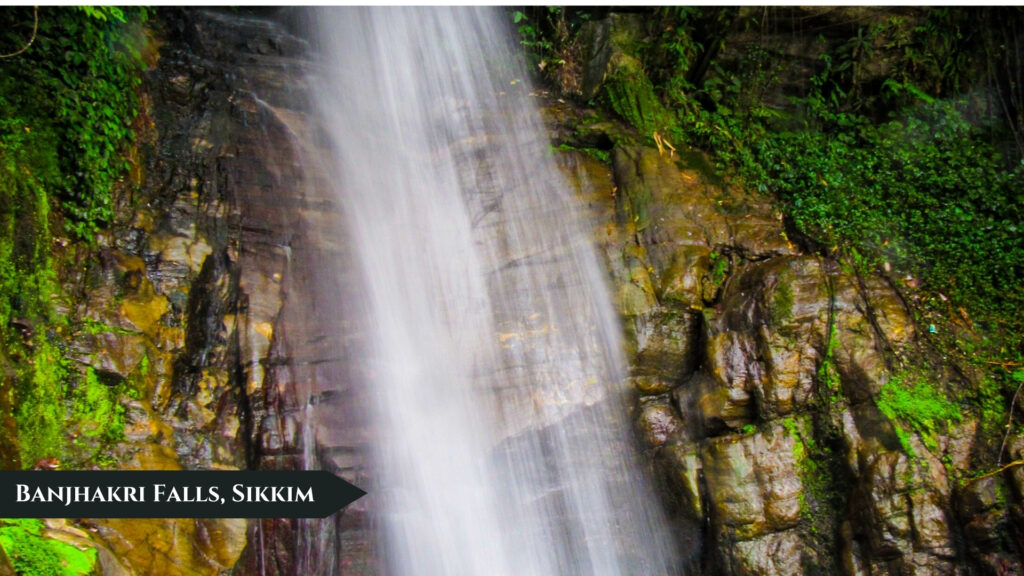
Banjhakri Falls, located near Gangtok, is a popular tourist attraction known for its natural beauty and spiritual significance. Surrounded by rich greenery and peaceful ambiance, this beautiful waterfall is surrounded with traditional sculptures and prayer flags, creating a peaceful oasis where visitors can rejuvenate their spirits and connect with the healing energies of nature.
Frequently Asked Questions (FAQs)
Where is Rimbi Falls located?
Rimbi Falls is located near Pelling in West Sikkim, India.
What are the best times to visit Rimbi Falls?
The best times to visit Rimbi Falls are during the spring (March to May) and autumn (September to November) months when the weather is pleasant and the surroundings are lush and green.
Are there any entry fees to visit Rimbi Falls?
No, there are generally no entry fees to visit Rimbi Falls as it is a natural attraction. Visitors can explore the falls freely.
What facilities are available near Rimbi Falls? ‘
Basic amenities such as parking facilities and public restrooms are available near Rimbi Falls. There are also small local eateries and stalls nearby where visitors can purchase snacks and refreshments.
How can I reach Rimbi Falls?
You can reach Rimbi Falls by road from nearby towns like Pelling. The nearest major airport is Bagdogra Airport in West Bengal, and the nearest major railway station is New Jalpaiguri (NJP) Railway Station.
Is Rimbi Falls safe to visit?
Rimbi Falls is generally safe to visit, but visitors should exercise caution near the water and follow any safety signs or guidelines.
What are some other attractions near Rimbi Falls?
Nearby attractions include Khecheopalri Lake, Pemayangtse Monastery, Singshore Bridge, Rabdentse Ruins, Yuksom, and Tashiding Monastery.
Can I take photographs at Rimbi Falls?
Yes, visitors are allowed to take photographs at Rimbi Falls. It’s a great spot for capturing the natural beauty of the waterfall and its surroundings.
Are there guided tours available for Rimbi Falls?
While formal guided tours may not be common, local guides can often be hired at Pelling or nearby areas to provide insights and enhance your experience of Rimbi Falls.
What should I wear and bring when visiting Rimbi Falls?
Wear comfortable clothing and sturdy footwear suitable for walking on natural terrain. It’s also advisable to bring sunscreen, sunglasses, a hat, insect repellent, and a reusable water bottle.



